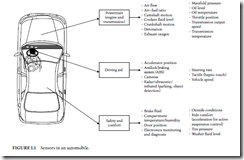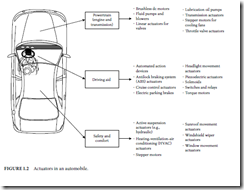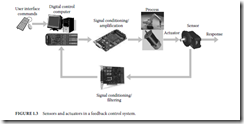Chapter Highlights
• Sensing, actuation, and control in system instrumentation
• Application scenarios of sensors and actuators
• Relevance of mechatronic engineering in instrumentation
• Human sensory system and its analogy to engineering sensing process
• Common control system architectures: Feedback and feedforward control, digital control, pro- grammable logic control, distributed control
• Instrumentation process and steps
• Application examples: Networked application, telemedicine system, homecare robotic system, water quality monitoring
• Organization of the book
1.1 Role of Sensors and Actuators
This is an introductory book on sensors, transducers, and actuators and their integration into the engi- neering system. Specifically, the book deals with instrumenting an engineering system, particularly a con- trol system, through the incorporation of suitable sensors, actuators, and the required interface hardware. Sensors (e.g., semiconductor strain gauges, tachometers, RTD temperature sensors, cameras, piezo- electric accelerometers) are needed to measure (sense) unknown signals and parameters of an engineer- ing system and its environment. Essentially, sensors are needed to monitor and learn about the system. This knowledge will be useful not only in operating or controlling the system but also for many other purposes such as process monitoring; experimental modeling (i.e., model identification); product test- ing and qualification; product quality assessment; fault prediction, detection, and diagnosis; warning generation; and surveillance. As an example, a common application of sensors is in automobiles where a vast variety of sensors are used in the powertrain, driving assistance, safety and comfort, and so on,
as presented in Figure 1.1.
Actuators (e.g., stepper motors, solenoids, dc motors, hydraulic rams, pumps, heaters/coolers) are needed to drive a plant. As another category of actuators, control actuators (e.g., control valves) perform control actions, and in particular they drive control devices. Micro-electromechanical systems (MEMS) use microminiature sensors and actuators. Yet, the scientific principles behind these devices are often the same as those of their macro counterparts. For example, MEMS sensors commonly use piezoelec- tric, capacitive, electromagnetic, and piezoresistive principles. MEMS devices provide the benefits of small size and light weight (negligible loading errors), high speed (high bandwidth), and convenient mass-production (low cost). Again, automobiles provide a fertile ground for various types of actuators. Some examples of automotive actuators are presented in Figure 1.2.
Sensors and actuators are indispensable in a control system. A control system is a dynamic sys- tem that contains a controller as an integral part. The purpose of the controller is to generate control signals, which will drive the process that is being controlled (called the plant) in a desired manner (i.e., according to some performance specifications), using various control devices. Specifically in a feedback control system, the control signals are generated based on the sensed response signals of the plant. Sensors, actuators, and other main components in a feedback control system are schematically shown in Figure 1.3.
1.1.1 Importance of Estimation in Sensing
The sensor measurement may not provide the true value of the required parameter or variable that is needed for two main reasons:
1. Measured value may not be the required quantity, and has to be computed from the measured value (or values) using a suitable model.
2. The sensor (or even the sensing process) is not perfect and will introduce measurement error.
Hence, sensing may be viewed as a problem of estimation, where the true value of the measured quantity is estimated using the measured data. Two main categories of error, model error and measurement error, enter into the process of estimation and will affect the accuracy of the result. The model error arises from how the quantity of interest is related to the quantity that is measured (or, the model of the system). Unknown (and random) input disturbances can also be treated under model error. The measurement error will arise from the sensor and the sensing process (e.g., how the sensor is mounted; how the data is collected, communicated, and recorded; etc.). It is clear that estimation (of parameters and signals) is a valuable step of sensing. Many methods are available for estimation. Some of them are presented in this book (e.g., least squares, maximum likelihood, Kalman filter [KF], extended Kalman filter [EKF], unscented Kalman filter [UKF]).
1.1.1 Innovative Sensor Technologies
Apart from conventional sensors, many types of innovative and advanced sensors are being developed. Several types are listed below:
• Microminiature sensors (IC-based, with built-in signal processing).
• Intelligent sensors (built-in information preprocessing, reasoning, and inference making to pro- vide high-level knowledge).
• Integrated (or, embedded) and distributed sensors. (These are integral with the components/ agents of a multi-agent system, and communicate with each other. In distributed sensing, there can be significant geographic separation between sensor nodes.)
• Hierarchical sensory architectures (low level sensory information is preprocessed to meet higher level requirements) → compatible with hierarchical control; each control layer is serviced by a corresponding sensor layer.


